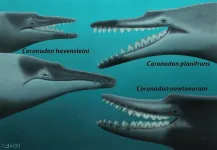(Press-News.org)
Chronic conditions such as type 2 diabetes, asthma, HIV infection, and mental illness may be greatly undertreated in the U.S. jail and prison population, suggests a new study from researchers at the Johns Hopkins Bloomberg School of Public Health.
For their analysis, the researchers used national health survey data covering 2018 to 2020 to estimate rates of chronic conditions among recently incarcerated people, and a commercial prescription database to estimate the distribution of medication treatments to the jail and prison population. Their analysis suggests that for many common and serious conditions, incarcerated people are substantially less likely to be treated compared to the general U.S. population.
The study found that recently incarcerated individuals with type 2 diabetes represented about 0.44 percent of the U.S. burden of the condition, but got only 0.15 percent of oral anti-hyperglycemic medications—nearly a threefold difference. Incarcerated individuals with asthma accounted for 0.85 percent of the total U.S. asthma population, but just 0.15 percent of asthma treatment volume, a more than fivefold difference.
The study will be published online April 14 in JAMA Health Forum.
“Our findings raise serious concerns about the access to and quality of pharmacologic care for very common chronic health conditions among the incarcerated,” says study senior author G. Caleb Alexander, MD, professor in the Department of Epidemiology at the Bloomberg School. “We knew going in that the U.S. incarcerated population has a higher prevalence of some chronic diseases. But we were really surprised by the extent of potential undertreatment that we identified.”
Prior studies have found evidence that health care provided to the U.S. incarcerated population—roughly two million individuals—is often understaffed, underfunded, and of poor quality. Yet studying health care issues among the incarcerated involves many challenges. Few studies have examined treatment of common and chronic diseases such as diabetes and asthma.
“Health care provided in jails and prisons is provided by a patchwork of health care providers, most commonly private contractors who do not widely share information about the services they provide to incarcerated people,” says study co-author Brendan Saloner, PhD, an associate professor in the Bloomberg School’s Department of Health Policy and Management. “The lack of transparency means that advocates and policymakers have a very incomplete picture of the medicines that are available during a stay in jail or prison.”
The lack of transparency also makes it difficult to research. For their study, the researchers generated two sets of estimates: one for the prevalence of specific conditions among recently incarcerated inmates, the other on the percentage of common chronic illness prescriptions going to jails and state prisons.
For the disease prevalence estimates, the researchers used recent data from U.S. government-sponsored National Surveys on Drug Use and Health. These annual surveys don’t cover prison and jail populations directly, but the researchers estimated condition prevalence among adult survey respondents who either had or had not reported being on parole or having been arrested and booked in the prior year. They combined these figures with U.S. Census data, and generated population estimates for state prisons and local jails to gauge the approximate numbers of incarcerated and non-incarcerated individuals with different conditions.
To get a sense of prescriptions dispensed to the incarcerated vs. the non-incarcerated populations, the researchers used data from the same time period from the health care technology company IQVIA. Because of the lack of data on federal prison inmates, the incarcerated population for the analysis included only individuals in local jails and state prisons. The authors made adjustments for the possibility of missing data, and note that their numbers may underestimate disparities between incarcerated individuals and their counterparts.
The analysis yielded estimates for the prevalence of chronic conditions that suggested particularly heavy burdens of some illnesses in the incarcerated population—for example, hepatitis (6.08 percent prevalence among the incarcerated vs. 1.41 for the non-incarcerated), HIV infection (0.84 percent vs. 0.28 percent), depression (15.10 percent vs. 7.64 percent), and severe mental illness (13.12 percent vs. 4.89 percent).
As for prevalence-treatment differentials among the incarcerated, the study also found that incarcerated individuals with HIV represented about 2.2 percent of the U.S. burden of the condition, but got only 0.73 percent of HIV antivirals—a threefold difference. Incarcerated individuals with severe mental illness represented an estimated 1.97 percent of disease burden, but only 0.48 percent of treatment volume consisting of antipsychotics and mood stabilizers, a fourfold difference.
Alexander says that the findings may reflect not only institutional neglect but also factors such as the temporary nature of many local jail stays, and the high prevalence of mental illness—which tends to complicate treatment of other conditions—in the incarcerated population.
“We hope our results will motivate further investigations that continue to explore these vital matters using a variety of data sources,” he says.
“Estimated Use of Prescription Medications Among Individuals Incarcerated in Jails and State Prisons in the US” was co-authored by Jill Curran, Brendan Saloner, Tyler Winkelman, and G. Caleb Alexander.
# # #
END
About The Study: In a study of matched pairs of counties that reopened with in-person versus virtual instruction at the secondary school level in the 2020 to 2021 academic year, counties with in-person school instructional models early in the COVID-19 pandemic experienced increases in county-level COVID-19 incidence at six and eight weeks after in-person reopening, compared with counties with virtual instructional models.
Authors: Meredith Matone, Dr.P.H., of Children’s Hospital of Philadelphia, is the corresponding author.
To access the embargoed study: Visit our For The ...
About The Study: The findings of this study of survival outcomes for 1,618 U.S. counties suggest that greater representation of Black primary care physicians (PCPs) in the PCP workforce is associated with improved survival-related outcomes for Black individuals, although there was a dearth of U.S. counties with at least one Black PCP during each study time point. Investments to build a more representative PCP workforce nationally may be important for improving population health.
Authors: John E. Snyder, M.D., M.S., M.P.H., and Rachel D. Upton, Ph.D., of the U.S. Department of Health and Human Services in Rockville, Maryland, are the corresponding ...
About The Study: In this study of 81,755 Medical College Admission Test examinees, American Indian or Alaska Native, Black, and Hispanic students reported lower parental educational levels, greater educational and financial barriers, and greater discouragement from pre-health advisers than white students. These barriers may deter groups underrepresented in medicine from applying to and matriculating at medical school.
Authors: Jessica Faiz, M.D., M.S.H.P.M., of the Veterans Affairs Greater Los Angeles Healthcare System and UCLA in Los Angeles, is the corresponding ...
Artificial Intelligence (AI) experts have been challenged to help a new space mission to investigate Earth’s place in the universe.
The Ariel Data Challenge 2023, which launches on 14 April, is inviting AI and machine learning experts from industry and academia to help astronomers understand planets outside our solar system, known as exoplanets.
Dr Ingo Waldmann, Associate Professor in Astrophysics, UCL (University College London) and Ariel Data Challenge lead said:
“AI has revolutionised many fields of science and industry in the past years. The field of exoplanets has fully arrived in the era of big-data and cutting edge AI is needed to break ...
The researchers of the FinEst Centre for Smart Cities of Tallinn University of Technology (Estonia, Europe) developed the DigiAudit platform to monitor and analyse energy use and indoor climate indicators of buildings and large real estate portfolios in real time. Thinnect, an Estonian IoT start-up company, will help sell the solution and market it worldwide.
We can only reach zero-emission buildings when we have reliable data
The European Union has set a target for all buildings to be zero-emission, or near-zero energy, by 2050. However, there is no reliable data on the energy consumption of many buildings, so it is not possible to monitor the condition ...
Researchers from the University of Eastern Finland, the University of Turku, and Tampere University have developed an artificial intelligence-based method for virtual staining of histopathological tissue samples as a part of the Nordic ABCAP consortium. Chemical staining has been the cornerstone of studying histopathology for more than a century and is widely applied in, for example, cancer diagnostics.
“Chemical staining makes the morphology of the almost transparent, low-contrast tissue sections visible. Without it, analysing tissue morphology is almost impossible for human vision. Chemical staining is irreversible, and in most ...
Québec City, April 14, 2023 - Fuchs' endothelial corneal dystrophy, a degenerative eye disease, causes progressive vision loss that can induce blindness. It is the leading cause of corneal transplantation, but the scarcity of grafts hinders its treatment. A research team from Université Laval and Université de Montréal has identified a way to slow the disease and even avoid transplantation if diagnosed at an early stage.
In people with the disease, the endothelial cells at the back of the cornea die more quickly than in healthy people. "Everyone loses them at a slow rate, slow enough to make it to the end of our lives ...
A new study published in the journal PeerJ by Robert W. Boessenecker (CofC), Brian L. Beatty (NYIT), and Jonathan H. Geisler (NYIT) reports a wealth of new fossils of the early toothed baleen whale Coronodon from Oligocene (23-30 million years old) rock layers near Charleston, South Carolina. These include five new skulls, representing two new species: Coronodon planifrons and Coronodon newtonorum, and young juveniles of Coronodon havensteini – first named from a single skull by this team in 2017. Coronodon is one of the most primitive members ...
While the wheel does not need to be reinvented, there are benefits to the development of new nano-wheels, according to a multi-institute research team based in China. The group fabricated a novel family of metallic compounds, each of which exhibit unique properties desirable for next-generation technologies, such as advanced sensors.
Their findings were made available online on March 12 in Polyoxometalates.
“Polymetallic complexes are of great interest not only for their appealing molecular structure but also ...
There is a need for new drugs. For example, many of the antibiotics that we have been using for a long time are becoming less effective. Chemists and pharmaceutical scientists are frantically searching for new active substances, especially those that can penetrate cell membranes, as these are the only ones that patients can take orally in the form of a tablet or syrup. Only these active ingredients pass through the intestinal wall in the small intestine and enter the bloodstream to reach the affected area in the body. For active ingredients that cannot penetrate the cell membrane, physicians have no choice but to inject them directly into ...




